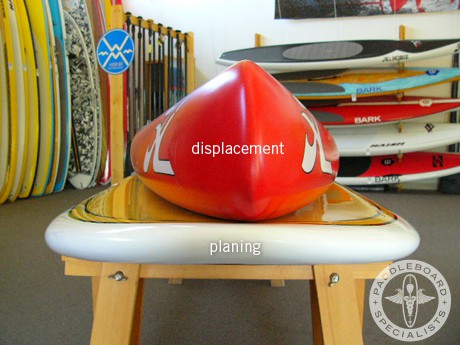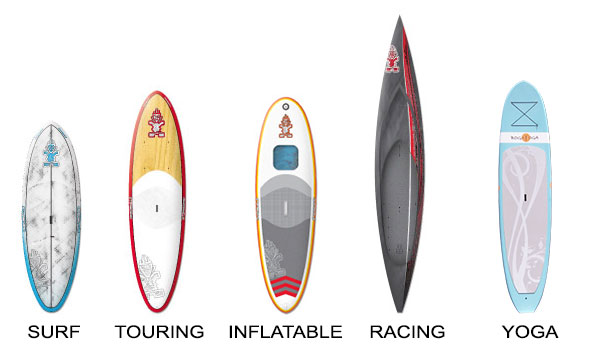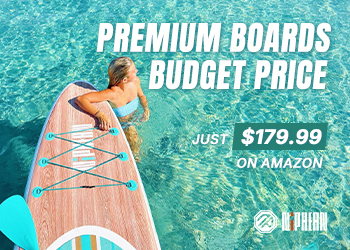If you are not new to paddle boarding, you’ll know that there actually several types of boards as there are various ways to do stand-up paddle boarding. This article will help you pick the most suitable paddle board for you according to its qualities.
Let’s brush up on what you need to look for in a stand up paddle board.
SUP Design Characteristics
Hull Design
Hull design is a complicated science, but it wouldn’t hurt to familiarize yourself with it. Stability is very crucial in a stand up paddle board, and it greatly depends on the hull design. Basically, there are planning and displacement hulls. The former is flatter and wider. It rides easily on the water’s surface so it is exceptionally stable and versatile as you can also use it for surfing. Displacement hulls, on the other hand, resemble a V-shape boat. This hull design is for those who are in need of speed more than stability.

SUP Width
The speed and the glide of your board are dependent on its width. Simply put, the narrower the board, the faster you can paddle, but you can potentially sacrifice your stability. If you’re having trouble with your balance, it is best to get a very wide board. Even a few inches off the width of the board matter.
Height and Weight
Consider a board with a height that is in proportion with your own height. A very wide board forces you to exert more effort as you get your paddle into the water. There is a recommended weight range for each stand up paddle board. Newbies are suggested to use those on the lighter end of the scale.
Thickness and Volume
Take into consideration your own weight as you look for a paddle board. Low volume boards can’t support heavier riders. The higher the volume, the more weight it can bear.
Length
Length has something to do with easy maneuverability. Longer boards are recommended for straight and fast paddling, and shorter ones are for catching the waves. The shorter the board, the easier it turns.
Fin Setup
This quality is already meant for more specialized SUP. Basically, those with fewer fins can only be used in flat water while those with 3 or 5 fins can be used in surfing.
Construction
Durability is important in picking a stand up paddle board. Find out about the materials used in the construction of your board. Traditional boards are prone to air accumulation, composite sandwich boards are lightweight, but very fragile; soft boards are meant for beginners who paddle in shallow water. If your goal is to choose the most durable kind, buy an inflatable board.

The basic characteristics such as nose and tail shapes, rocker, bottom contour, and rails are also important. In choosing the most ideal SUP, you have to list down your personal preferences first. Most importantly, you have to know what you will use the board for. Buy an all-around stand up paddle board to have a bit of everything or take your time to find a purpose-designed board if you know think that you will focus on a specialized paddle board activity. It’s safe to say that by knowing what you will use it for, you will find out what qualities you will look for in stand up paddle board. Most importantly: See if you can rent or try different boards to get a feeling for the types of boards available before you make a decision.
SupBoardGuide Editorial Team
Latest posts by SupBoardGuide Editorial Team (see all)
- Best Inflatable Paddle Boards (iSUPs), 2025 - July 3, 2025
- Best Cheap Inflatable Paddle Boards (2025) - March 26, 2025
- SeaGods Carta Marina CX Review - January 31, 2025







Hi,
I have tried paddle boarding a few times and have really enjoyed myself. I am looking into buying a board but I am having trouble finding something that I think would work for me. I live on a small bay where the water can be flat sometimes, but most of the time is quite choppy from wind and other boaters using the bay for water sports. Sometimes we even get white caps from all the wind. Because of the conditions I am not sure what type of board would be best for me. Based on what I have been reading I have been leaning towards a solid construction planning board but I’m not sure how it would handle the chop. Any advice or recomendations would be great!
Thanks!
Hey Andrew! Sarah here, I spend half my time next to the ocean battling winds and currents so I feel you!
You are definitely on the right path looking at a hardboard. I still love my inflatables because of their convenience but when that howl whips up, it’s nice to be on something that has a bit more resilience.
Racing boards or touring boards that have a pronounced nose are fantastic for windy choppy waters. They can slice through small chop and have responsive maneuvering. Touring boards you will get a bit more stability than a racer, which you may appreciate if you are starting out! Just look for a bit of rocker (upturned angle) in the nose and a pointed nose with a squared off bottom. The rocker helps combat wind and chop and the squared bottom aids to the stability you lose through having a pointed nose. Fanatic does an awesome touring board “Ray” as well as the “Naish Glide Touring”. Depending on what your budget is, they could be perfect. Obviously, there is a huge price difference between them and something like the ThursoWaterwalker which is a similar design, but hardboards tend to always cost a bit more. BIC Sports does a 12’6 Explore which is a bit cheaper than the others I mentioned. I haven’t actually ridden the Explore but been on some of their other boards and was pleasantly surprised by the quality! Hope that helps 🙂